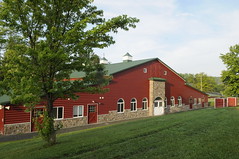One of the most popular arts and crafts activities at Camp Starlight is tie-dying. There is no better way to liven-up a t-shirt, tank top, 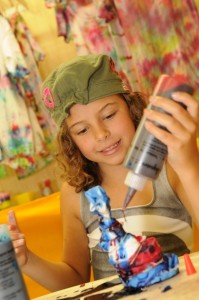 pillow case, or pair of socks than a fun tie- dying activity! Rain or shine Camp Starlight loves to tie- dye! Even though it may seem better at Starlight… you don’t need to be in the Carriage House, surrounded by Leslie Schwartz and her talented team of Arts and Crafts Specialists to make something fantastic. You can follow these simple steps at home with your parents, siblings, grandparents, and friends to create something awesome to bring to camp in 2011!
pillow case, or pair of socks than a fun tie- dying activity! Rain or shine Camp Starlight loves to tie- dye! Even though it may seem better at Starlight… you don’t need to be in the Carriage House, surrounded by Leslie Schwartz and her talented team of Arts and Crafts Specialists to make something fantastic. You can follow these simple steps at home with your parents, siblings, grandparents, and friends to create something awesome to bring to camp in 2011!
#1.) Preparing the Shirt for Tying and Dying
• First, the shirt must be 100% cotton or it will not hold the dye.
• Always prewash the shirt. It contains a fabric finish when it is new and this prevents all the dye from being absorbed into the fibers. Washing will remove the finish.
• Pre-soak the shirt in 1 cup of soda ash to 1 gallon of water. If you mix this with your hands, wear rubber gloves. Soak for 15 minutes to 1 hour. The soda ash solution losses its effectiveness after 1 hour. You can no longer use it. Dispose of the soda ash solution.
• Squeeze out the soaked shirt. Wear rubber gloves when doing this. You are now ready to tie your shirt.
#2.) HOW TO TIE THE ITEM
These are the directions for creating a swirl design. Make sure to place a large sheet of plastic down to protect the table.
• Place the shirt out flat with the front side down. The side that is down always has the better appearance.
• Place a clothes pin where you wish the center of the swirl to be. Remember, that the center of the shirt may come down low on the person wearing it. You may want to have the center of the swirl off center, near the top, or near the bottom.
• Holding the clothes pin, swirl the shirt. Gather up loose edges as you go. The shirt should not go up in a point, but rather gather up only a few inches above the work surface. When you are finished, it will be similar in size and shape to a round layer of cake.
• Gently lift the twisted shirt and place a rubber band across the shirt, crossing the center point. Add two more rubber bands, creating six “pie” sections. These do not have to be equal in size.
• Turn the shirt over and make sure that the rubber bands cross or X across the center of the swirl.
• You are now ready to dye.
• Cover the tables with plastic sheeting to prevent the dye from staining the surface.
• If you are dying outside, you can work on the grass.
• Place an entire newspaper under the tied t-shirt. Have the newspaper in 2 large sections. The newspaper will absorb the dyes that overflow the shirt.
• Remember the color scheme that you will be using.
• Put on the rubber gloves.
• Using the squirt bottles containing the mixed dye, start with your first color. Carefully tip the bottle over and point it at the triangular “pie section” of the tied shirt. Start near the edge and squeeze the dye out gently. Move toward the center as you dye that section.
• Change colors as you go around the shirt. For three colors you will repeat the colors twice on each side.
• When you turn over the shirt, flip the newspaper to a clean section.
• You will be able to see the colors used on the sections of the dyed side. Repeat the same colors on the second side.
• When the shirt is dyed on both sides, place the shirt inside a plastic bag. Twist tie this closed. You will leave the shirt inside the bag for 24
#4.) Washing and Drying the Tie-Dyed Shirt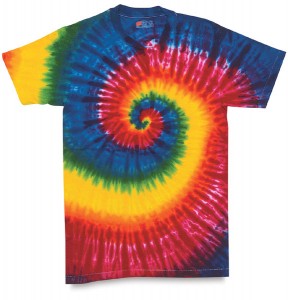
• Again, leave the dyed shirt inside a sealed plastic bag for at least 24 hours.
• There are two ways to rinse and wash a dyed shirt (multiple or single shirts).
• The first way is to rinse the shirt out in a sink or with a hose until most of the dye is gone and the water runs clear. Remove the rubber bands and continue to rinse, if necessary.
• Place rinsed shirt in a washer and wash with detergent. ((Warm water is okay.)
• You may place the shirt in the dryer or line dry, if you choose.
• The 2nd way works well with a single dyed shirt. You may skip the rinsing and instead place the shirt in the washer and wash it alone in a complete load of water. No pre-rinsing is necessary. Dry.
• Now wear your shirt!
Just in case you need a few helpful tips… here are Leslie Schwartz’s Top Tips for creating an awesome masterpiece.
- Mix the soda ash and dye solutions ahead of time. Store mixed dyes in the refrigerator so they don’t lose strength.
- Make sure the rubber bands are on super tight; the tighter they are the better the shirt will come out.
- Make sure to wear rubber gloves.
- Pick colors that will look good together – like turquoise, navy blue, crimson, etc. If you want high contrast like yellow and purple, be sure to do the colors at separate times so the purple and yellow cannot mix! Maybe you can do the first (lighter) color one day and the second color the following morning.
- Rinse project after dyeing with warm water, followed by a cool water rinse.
- Have Fun!
- Have Fun!
- Have Fun!



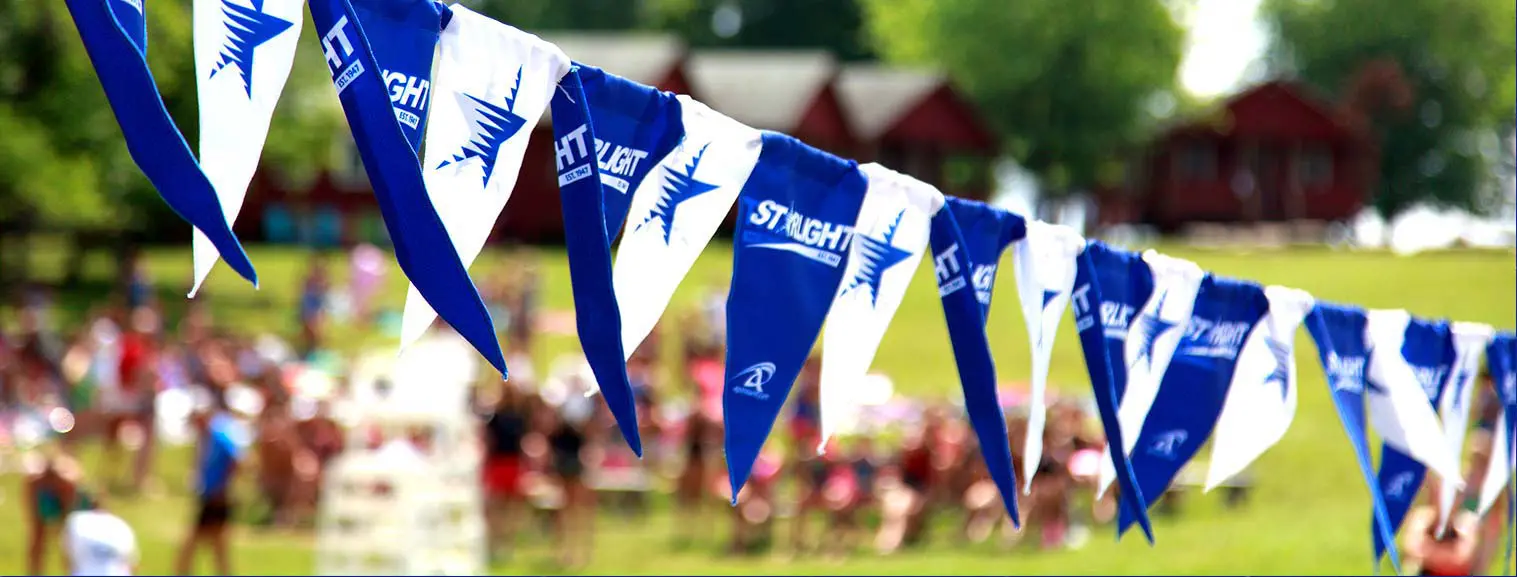
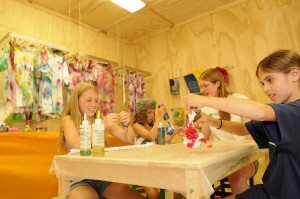
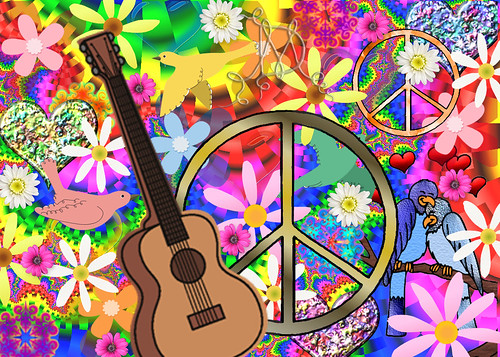 When I think about “camp songs,” I immediately think about singing around campfires, but each year at camp also has a distinct popular music soundtrack. Recently, campers weighed in on Twitter about the tunes that remind them of past summers and that got me thinking about what the United States and camp was like in the 1960s and 1970s.
When I think about “camp songs,” I immediately think about singing around campfires, but each year at camp also has a distinct popular music soundtrack. Recently, campers weighed in on Twitter about the tunes that remind them of past summers and that got me thinking about what the United States and camp was like in the 1960s and 1970s.
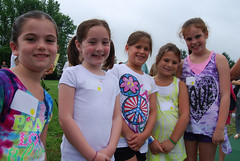 assumptions can be challenged, and where diverse people find ways to celebrate community and appreciate each other. One great thing about camp is that for a few weeks, the world grows a little smaller and everyone listens to the same soundtrack. In a fast-paced and interconnected world, camp “sounds” like the perfect place for connecting with others and as Hadley says, every summer adds up to “good times for campers and staff.” It’s often only later that campers realize how much the experience has shaped them and the way they see the world–much like how hit songs can illuminate the past in retrospect. The music (and fashions) may change through the years, but the core camp experience never goes out of date.
assumptions can be challenged, and where diverse people find ways to celebrate community and appreciate each other. One great thing about camp is that for a few weeks, the world grows a little smaller and everyone listens to the same soundtrack. In a fast-paced and interconnected world, camp “sounds” like the perfect place for connecting with others and as Hadley says, every summer adds up to “good times for campers and staff.” It’s often only later that campers realize how much the experience has shaped them and the way they see the world–much like how hit songs can illuminate the past in retrospect. The music (and fashions) may change through the years, but the core camp experience never goes out of date. Moving from one year towards the next has me thinking about summer camp in the past and future. For over a century, summer camps in the United States have helped millions of American children develop and grow as well as start negotiating their worlds outside of immediate families and neighborhoods. At first, a small number of elite camps only served boys, and primarily Protestant boys at that — but by the time the prosperous years after World War II were in full swing, approximately one in six American children went to camp, usually for eight weeks at a time. Throughout the 20th century, camps changed to serve all children including varying camp lengths, welcoming girls, and opening their gates to all races.
Moving from one year towards the next has me thinking about summer camp in the past and future. For over a century, summer camps in the United States have helped millions of American children develop and grow as well as start negotiating their worlds outside of immediate families and neighborhoods. At first, a small number of elite camps only served boys, and primarily Protestant boys at that — but by the time the prosperous years after World War II were in full swing, approximately one in six American children went to camp, usually for eight weeks at a time. Throughout the 20th century, camps changed to serve all children including varying camp lengths, welcoming girls, and opening their gates to all races.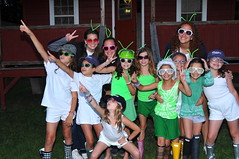 As summer camps have become more inclusive, the world that children experience both in the United States and globally has also become very different. Many children have access to a much broader world through travel, moving images, or other technologies, but some things just haven’t changed. For instance, our pre-college age identities are still informed by interactions with peers and people connected to our individual worlds, directly translating to the people we make direct contact with. While community is still central to human development, many of our daily communities are no longer bound by neighborhood blocks tied to local shared institutions and celebrations. Our families and extended social circles filter across state, nation and even electronic borders.
As summer camps have become more inclusive, the world that children experience both in the United States and globally has also become very different. Many children have access to a much broader world through travel, moving images, or other technologies, but some things just haven’t changed. For instance, our pre-college age identities are still informed by interactions with peers and people connected to our individual worlds, directly translating to the people we make direct contact with. While community is still central to human development, many of our daily communities are no longer bound by neighborhood blocks tied to local shared institutions and celebrations. Our families and extended social circles filter across state, nation and even electronic borders.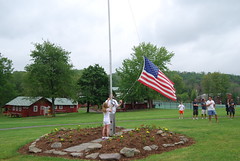 Past, present and future campers are all part of a lively and creative shared community where remembering a song, a person, an event, a skit, food or a poignant moment can instantly transport peers back to camp. So, what you would add to a time capsule to “capture” the timeless spirit of camp and why? We’d love to hear what alumni and present campers would include in an electronic time capsule, so get scanning or writing up those memories and lessons learned! If you’re not sure how to get started, ask questions in the comments below!
Past, present and future campers are all part of a lively and creative shared community where remembering a song, a person, an event, a skit, food or a poignant moment can instantly transport peers back to camp. So, what you would add to a time capsule to “capture” the timeless spirit of camp and why? We’d love to hear what alumni and present campers would include in an electronic time capsule, so get scanning or writing up those memories and lessons learned! If you’re not sure how to get started, ask questions in the comments below!
 Whether your Holiday Season has ended or is about to begin, summer camp season isn’t far away! In fact, on December 8th 2010, next year’s campers wore their camp shirts in numerous cities to mark the 200 Day Countdown To Summer. If you’ve never gone to camp, it may be difficult to understand what drives this passion for camp all year—but campers know that camp is contagious, FUN, and essential! The camp experience helps children develop into well-rounded adults in enormous and complex ways, and that’s really important—but having FUN and intense youthful experiences is how it all happens. That’s the brilliant combination of camp. The experience includes serious AND hilarious moments—often simultaneously! The whole experience is much like the two sides of a single coin, or the double-faced image of Janus, the Roman god who can see into the past and future at the same time—and the origin of the name for the first month—January.
Whether your Holiday Season has ended or is about to begin, summer camp season isn’t far away! In fact, on December 8th 2010, next year’s campers wore their camp shirts in numerous cities to mark the 200 Day Countdown To Summer. If you’ve never gone to camp, it may be difficult to understand what drives this passion for camp all year—but campers know that camp is contagious, FUN, and essential! The camp experience helps children develop into well-rounded adults in enormous and complex ways, and that’s really important—but having FUN and intense youthful experiences is how it all happens. That’s the brilliant combination of camp. The experience includes serious AND hilarious moments—often simultaneously! The whole experience is much like the two sides of a single coin, or the double-faced image of Janus, the Roman god who can see into the past and future at the same time—and the origin of the name for the first month—January. The serious side of camp includes feeling part of a unique community, identity development and participating through the years to make irreplaceable memories. If you don’t understand why camp is such an important American institution, in 1998 Ira Glass and the This American Life radio program attempted to investigate the topic—
The serious side of camp includes feeling part of a unique community, identity development and participating through the years to make irreplaceable memories. If you don’t understand why camp is such an important American institution, in 1998 Ira Glass and the This American Life radio program attempted to investigate the topic— It also highlights how fun, tradition, stories, community and being human are all part of identity development at camp. With his signature quirky style, Ira assembled more “truth is stranger than fiction tales,” where real campers tell stories of camp in days gone by and explain why the camp experience is so special. Hundreds of campers responded to his call for stories and the program shares a selection, so if you’re interested in history and interpreting American culture, you’ll find the reminiscences fascinating. Just remember that all camp experiences are not like the stories told—the point of the program is to illustrate the intensity of the experience! It ends with campers talking about becoming camp alumni and how their camp experiences won’t ever be forgotten.
It also highlights how fun, tradition, stories, community and being human are all part of identity development at camp. With his signature quirky style, Ira assembled more “truth is stranger than fiction tales,” where real campers tell stories of camp in days gone by and explain why the camp experience is so special. Hundreds of campers responded to his call for stories and the program shares a selection, so if you’re interested in history and interpreting American culture, you’ll find the reminiscences fascinating. Just remember that all camp experiences are not like the stories told—the point of the program is to illustrate the intensity of the experience! It ends with campers talking about becoming camp alumni and how their camp experiences won’t ever be forgotten. As we all know, time passes and our camp years are limited by the fact that we’re only children once. It’s easy to feel briefly melancholy at year’s end as time waits for no one, but of course, December also means that the promise of a new year is around the corner! In January, we’d like to continue looking backwards and forwards while thinking about camp and we’d especially love to hear from camp alumni. What’s the funniest thing that happened to you at camp? How did camp contribute to your adult life? We’d like to hear about the memories you hold dear and close to your heart, or what you wish for campers next year? If you’re counting the days until camp starts, what are YOU planning?
As we all know, time passes and our camp years are limited by the fact that we’re only children once. It’s easy to feel briefly melancholy at year’s end as time waits for no one, but of course, December also means that the promise of a new year is around the corner! In January, we’d like to continue looking backwards and forwards while thinking about camp and we’d especially love to hear from camp alumni. What’s the funniest thing that happened to you at camp? How did camp contribute to your adult life? We’d like to hear about the memories you hold dear and close to your heart, or what you wish for campers next year? If you’re counting the days until camp starts, what are YOU planning?
 As children mature, they continue to develop and require more experiences where they can make independent choices without parents. If parents don’t allow children to make decisions and do things on their own, they won’t develop confidence or realize that they are not just extensions of their caregivers. It’s a tricky line that parents walk! Sometimes giving children room to spread their wings seems counter intuitive, but in order to grow into a self-reliant adult, children need to struggle without the offer of a quick fix. Even when parents can take care of things, the better choice is to support a child through the process of working through and solving problems. Long after a problem has been forgotten, a self-reliant child will remember hearing, “Wow! You amaze me! You really worked hard to figure that out.”
As children mature, they continue to develop and require more experiences where they can make independent choices without parents. If parents don’t allow children to make decisions and do things on their own, they won’t develop confidence or realize that they are not just extensions of their caregivers. It’s a tricky line that parents walk! Sometimes giving children room to spread their wings seems counter intuitive, but in order to grow into a self-reliant adult, children need to struggle without the offer of a quick fix. Even when parents can take care of things, the better choice is to support a child through the process of working through and solving problems. Long after a problem has been forgotten, a self-reliant child will remember hearing, “Wow! You amaze me! You really worked hard to figure that out.”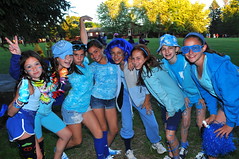 Of course, the
Of course, the  How would you describe the essential elements of a summer camp? Do the adventures of spending days with peers, learning new skills, trying new activities, bonfires and skits, great counselors— all the fun of the whole experience— first come to mind? These are definitely important elements of summer camp from a camper’s perspective, but there are a lot of other elements that have to be in place for a camp to be successful year after year. Have you ever wondered what it takes to set the scene and develop communities where good times can take place? I have.
How would you describe the essential elements of a summer camp? Do the adventures of spending days with peers, learning new skills, trying new activities, bonfires and skits, great counselors— all the fun of the whole experience— first come to mind? These are definitely important elements of summer camp from a camper’s perspective, but there are a lot of other elements that have to be in place for a camp to be successful year after year. Have you ever wondered what it takes to set the scene and develop communities where good times can take place? I have.